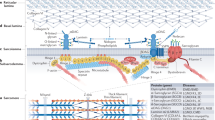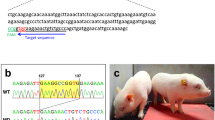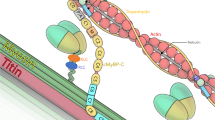Abstract
Duchenne muscular dystrophy (DMD) is an X-linked recessive disorder resulting in progressive degeneration of the muscle. It affects about 1 in 3,500 male children. Seeker's muscular dystrophy is a less severe disease allelic to DMD. Some 30% of DMD patients suffer from various degrees of mental retardation (see ref. 1 for review). The giant DMD gene spans about 2,000 kilobases and codes for a 14-kilobase messenger RNA and a protein of molecular weight 427,000 (ref. 2). DMD mRNA is most abundant in skeletal and cardiac muscle and less so in smooth muscle3,5. We reported that the expression of the gene is developmentally regulated during the differentiation of primary muscle cultures and in myogenic cell lines in a way similar to the expression of muscle-specific genes such as myosin light chain 2 and skeletal muscle actin5. Similar results have been obtained with human primary myogenic cells6. Significant levels of DMD mRNA are found in brain tissue5,7. Here we show that the transcript of the DMD gene and the amino terminal of the encoded protein differ in brain and muscle. The 5′ ends of these mRNA species are derived from different exons. The results suggest that the two mRNA types are transcribed from different promoters.
This is a preview of subscription content, access via your institution
Access options
Subscribe to this journal
Receive 51 print issues and online access
$199.00 per year
only $3.90 per issue
Buy this article
- Purchase on SpringerLink
- Instant access to full article PDF
Prices may be subject to local taxes which are calculated during checkout
Similar content being viewed by others
References
Moser, H. Hum. Genet. 66, 17–40 (1984).
Koenig, M., Monaco, A. R. & Kunkel, L. M. Cell 53, 219–228 (1988).
Monaco, A. P. et al. Nature 323, 646–650 (1986).
Hoffman, E. P., Monaco, A. P., Feener, C. C. & Kunkel, L. M. Science 238, 347–350 (1987).
Nudel, U., Robzyk, K. & Yaffe, D. Nature 331, 635–638 (1988).
Lev, A. A., Feener, C. C., Kunkel, L. M. & Brown, R. H. Jr J. biol. Chem. 262, 15817–15820 (1987).
Chamberlain, J. S. et al. Science 239, 1416–1418 (1988).
Melton, D. A. et al. Nucleic Acids Res. 12, 7035–7056 (1984).
Koenig, M. et al. Cell 50, 509–517 (1987).
Breitbart, R. E., Andreadis, A. & Nadal-Ginard, B. A. Rev. Biochem. 56, 467–495 (1987).
Auffray, C., Nageotte, R., Chambraud, B. & Rougeon, F. Nucleic Acids Res. 8, 1231–1241 (1980).
Chelly, J., Kaplan, J.-C., Maire, P., Gautron, S. & Kahn, A. Nature 333, 858–860 (1988).
Hoffman, E. P., Hudecki, M. S., Rosenberg, P. A., Pollina, C. M. & Kunkel, L. M. Neuron 1, 411–420 (1988).
Sanger, F., Nicklen, S. & Coulen, A. R. Proc. natn. Acad. Sci. U.S.A. 74, 5463–5467 (1977).
Maxam, A. M. & Gilbert, W. Proc. natn. Acad. Sci. U.S.A. 74, 560–564 (1977).
Mueller, P. & Hinnebusch, A. G. Cell 45, 201–207 (1986).
Author information
Authors and Affiliations
Rights and permissions
About this article
Cite this article
Nudel, U., Zuk, D., Einat, P. et al. Duchenne muscular dystrophy gene product is not identical in muscle and brain. Nature 337, 76–78 (1989). https://doi.org/10.1038/337076a0
Received:
Revised:
Accepted:
Issue Date:
DOI: https://doi.org/10.1038/337076a0



